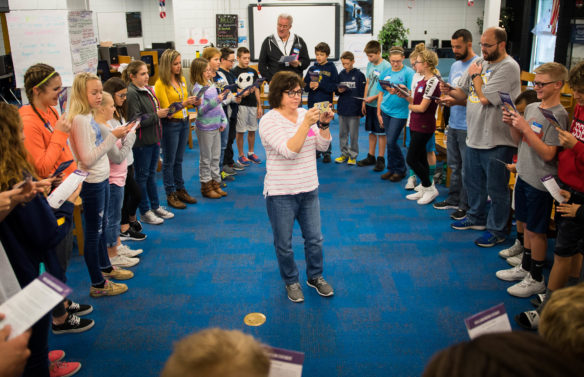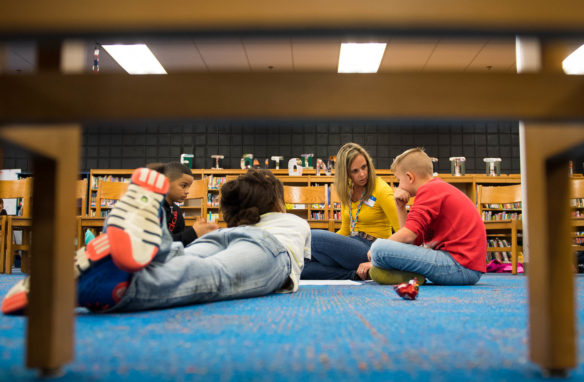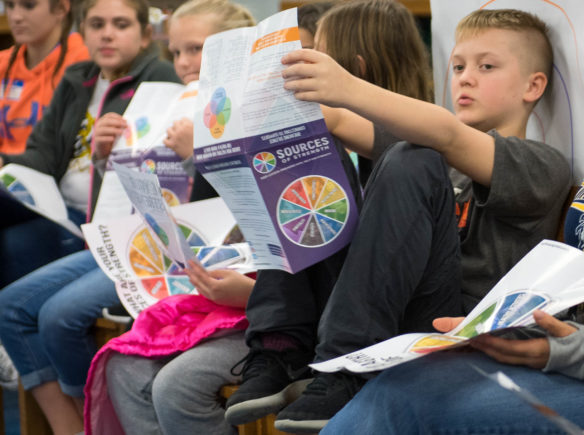
Rae Burgess, a Kentucky Department of Education safe schools consultant, records a video of Grant County Middle School students as they recite a pledge during the Sources of Strength training.
Photo by Bobby Ellis, Nov. 3, 2017
By Brenna R. Kelly
Brenna.kelly@education.ky.gov
Thirty middle school students, several teachers, a sheriff’s deputy, a custodian and a cafeteria manager sat in a circle in the Grant County Middle School library listing the things that give them strength to deal with life’s stresses.
Family, God, fishing, sports, good hair days and food all made the list.
“Everybody in this room already has a lot of sources of strength,” Rae Burgess, a Kentucky Department of Education safe schools consultant, told the group.
The discussion was part of Sources of Strength, a suicide prevention program with a twist. It mobilizes student social networks to promote positive behaviors with the goal of preventing bullying, substance abuse and ultimately, suicide.
Sources of Strength was developed in 1998 by crisis response expert Mark LoMurray after he responded to numerous teenage suicides. The evidence-based program is being used in more than 20 states and several countries. According to a 2010 study in the American Journal of Public Health, students in the program began to see adults as helpful, an idea that increased the most in students with suicidal thoughts.
So far, more than 30 Kentucky schools have been trained in the program thanks to a grant administered by the Kentucky Department of Behavioral Health. The department plans to train 20 more Kentucky schools this year and has funds to train about 30 more schools who apply and are approved.

Cheryl Million, right, the school librarian at Grant County Middle School, works with students to plan activities for the Sources of Strength program.
Photo by Bobby Ellis, Nov. 3, 2017
Burgess and fellow KDE safe schools consultant Doug Roberts have trained seven schools so far and plan to train at least four more this school year.
Suicide prevention programs in schools usually mean an assembly and a sad story, Roberts said.
“You present the information and within an hour you’re done, you check it off, submit the date that you did it and move on,” he said. “This is a totally different concept.”
Sources of Strength is culture-changing and on-going, with more students added as peer leaders each year.
The program is based on eight sources of strength – family, friends, mentors, activities, spirituality, health care, mental health and generosity – which research has shown are protective factors against suicide. The idea is to make sure students have multiple sources to draw from in times of crisis.
The peer leaders come from varying social groups – including athletes, students who might be considered loners, band members, gamers or those who are at risk dropping out.
“We tell teachers to nominate a wide variety,” Roberts said. “Make sure there’s somebody in the group who can connect with every group.”
Throughout the year, the students use social media, events, posters, contests and any other avenues they come up with to spread the message of help, hope and strength through the school. The peer leaders don’t try to solve other student’s problems, but connect them with and a trusted adult if needed.
The program has been in Butler Traditional High School (Jefferson County) for three and a half years, said health teacher Mary Wurst, who coordinates the program. More than 80 of the nearly 1,700 students at the school have been trained as peer leaders, she said.
“They are very good at being the eyes and ears of the building,” she said. “They will bring kids who they find out are in crisis to the adult mentors, but even more, if they just see a student who is having problems they will take them under their wing themselves.”
More than 30 students attend weekly meetings that are open to every student at the school. Students also learn about the program in their 9th-grade health class, Wurst said.
“I’ve taught for 25 years and I haven’t heard of or seen anything that’s this effective,” she said. “It should be in every school.”
Wurst believes the program works because students take ownership and because of the focus on positivity.
“The words ‘suicide prevention’ don’t even really come up,” she said. “It’s an upstream model. If you are doing all of these things, hopefully that prevents students from even getting to the point of depression.”
Wurst has had several principals and counselors call asking for her help to implement the program.
“Unfortunately, it’s often after they have had a suicide,” she said. “This could have possibly prevented that tragedy.”
Grant County School Psychologist Allison Stone learned about the program at a conference and knew it would be a good fit for the district’s middle and high school.
“I really liked it because it was a different aspect of suicide prevention,” she said. “This is something that’s going to be peer-led and they are the ones who know what’s going on and can reach out to connect students to adults.”
More than 50 students and 15 teachers and staff trained for the program at Grant County High School. The same day the group started, the @BravesStrong Twitter account was created and began spreading the Sources of Strength message.
“Giving kids an idea and letting them run with it, and seeing what they create is really powerful,” she said. “We can’t wait to see how creative they are.”
At the day-long middle school training, which also included the school’s family resource center director and a youth pastor from a community church, Roberts explained the eight sources and students took turns giving examples of times when they found strength during a crisis.
One student shared how the community helped his family when his house burned down, another shared that her grandmother helped her when she had problems with her mother. Another student talked about how he struggled when two of his grandparents died.
“At any given time in your life, you’re not going to have all the sources,” Roberts said, “but the more strengths you can pull from the better you will able to help others, and the better it will be for your life.”
Burgess told the students that peer leaders aren’t expected to be psychologists or have all the answers, they are the connectors.

Alex Persich, a 6th-grader at Grant County Middle School, looks at a strength wheel during training. Students are urged to focus on the eight sources of strength – family, friends, mentors, activities, spirituality, health care, mental health and generosity.
Photo by Bobby Ellis, Nov. 3, 2017
“It’s your job to look for changes in people who maybe need a little assistance. Your adult advisers can help,” Burgess said. “We don’t expect you to be the person who goes in and solves the problem.”
Health and physical education teacher Dustin Plunkett said he was surprised how quickly the students from different backgrounds and social groups accepted each other during the training.
Before the day was over, students had planned social media campaigns on Instagram, a wall of their handprints as founding members and a poster displaying the names of trusted adults in the school.
He said he hoped the program would break down barriers between groups and lead to what he called “a social network explosion.”
“I want them to go out and talk to their small groups and then all of the groups can begin to connect in some way,” he said, “and what it will do is give students places and people to go to when they are going through a tough time or when they are stressed out. Their inner circle will become larger.”
MORE INFO…
Rae Burgess Rae.Burgess@education.ky.gov
Doug Roberts Doug.Roberts@education.ky.gov
Mary Wurst Mary.Wurst@jefferson.kyschools.us
Allison Stone Allison.Stone@grant.kyschools.us
Dustin Plunkett Dustin.Plunkett@grant.kyschools.us




Leave A Comment